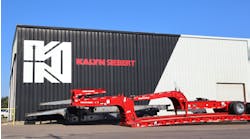CLEVELAND, Ohio— Lighting is the third most common type of out-of-service violation in North America, according to the 2020 Commercial Vehicle Safety Alliance International Roadcheck. They accounted for 13.5% of the OOS vehicle violations, and “lamps inoperable” was the number one violation overall.
Costly roadside repairs and blemishes on a fleet and driver’s CSA score are a few of the more severe consequences resulting from damaged/non-functioning lighting systems. And the cause of ranges from wayward rocks spit up by the asphalt to a more corrosive culprit assaulting the tractor-trailer’s underbelly: magnesium chloride.
This chemical compound is used by municipalities to melt snow and ice and can wreak havoc on cables, noted Al Anderson, VP of sales and marketing of Peterson Manufacturing at TMC's 2021 fall meeting. Another issue is “technicians probing the wires with the test light even though we've told them for years not to please do that,” Anderson said.
To give fleets a fighting chance against this prevalent problem, and better CSA scores, the company created the PetersonPATRIOT Modular Harness System. The waterproof wiring harness with a mount base about the size of a 3x5” index card was designed to protect lighting systems from corrosion, while also reducing maintenance costs and trailer downtime. The color-coded, one-way connectors are easy to distinguish from each other, and keyed to prevent assembly errors. The plastic harness easily can be easily bolted to an optimal position on the trailer, and in the event of damage, the wounded cable can be quickly detached and swapped out.
“By sealing [the system] in a composite enclosure, it's fully protected from moisture and road de-icing chemicals,” Anderson explained. “Additionally, the module’s compact size allows for a lot of flexibility when choosing a mounting location.”
A main advantage is the use of Peterson’s Maxi-Seal technology, which features over-molded amp-style connectors to keep moisture out, and if the cabling sheath is breached, an Integrated Moisture Barrier prevents moisture from wicking throughout the entire system. The use of silicon seals and built-in locking clips keep out moisture, as well.
While the harness system is more robust, damage could still occur. When that happens, Anderson said the carrier can simply splice the wire when the damage is discovered to “finish the mission and deliver the load,” and then replace the cable at the shop. The 5-year warranty against defects and corrosion would continue unabated.
Overall, the PetersonPATRIOT is best utilized by fleets that turn trailers over every 5 to 7 years, require advanced corrosion resistance and use limited add-on electrical accessories.
Anderson also gave one other important reason to reduce lighting issues: “Once an inspector has cause to start an inspection, they can start looking much deeper into the vehicle, opening up opportunities for other defects that may or may otherwise not be found.”










